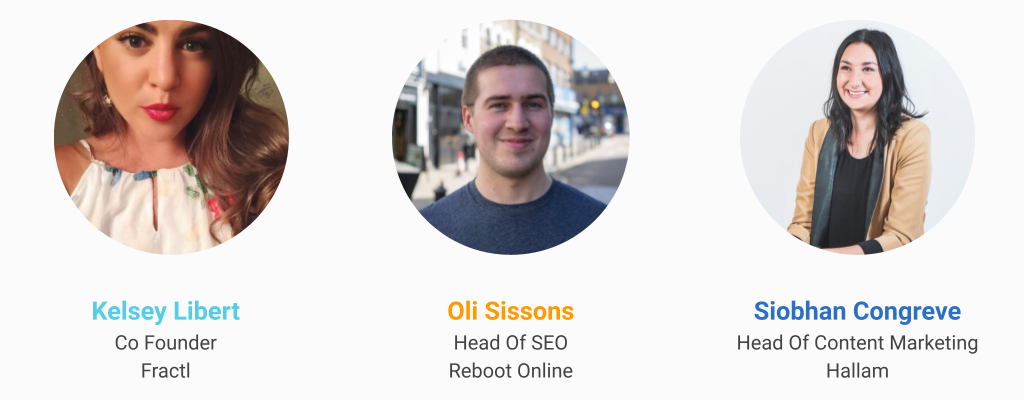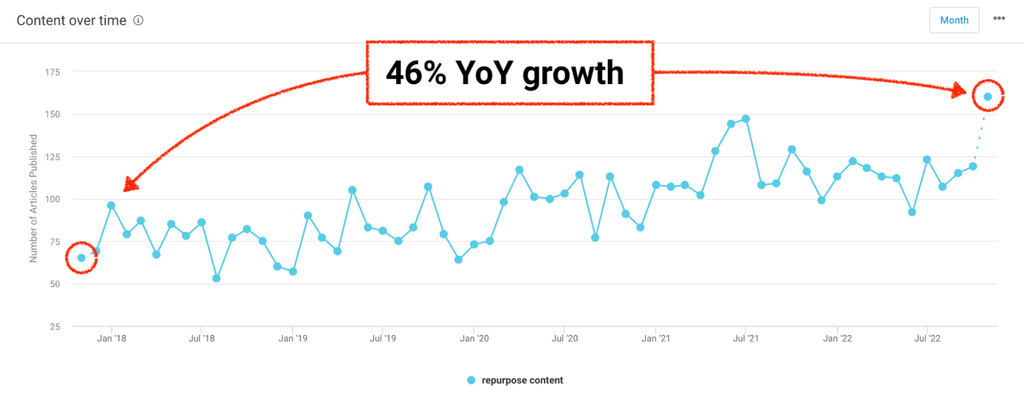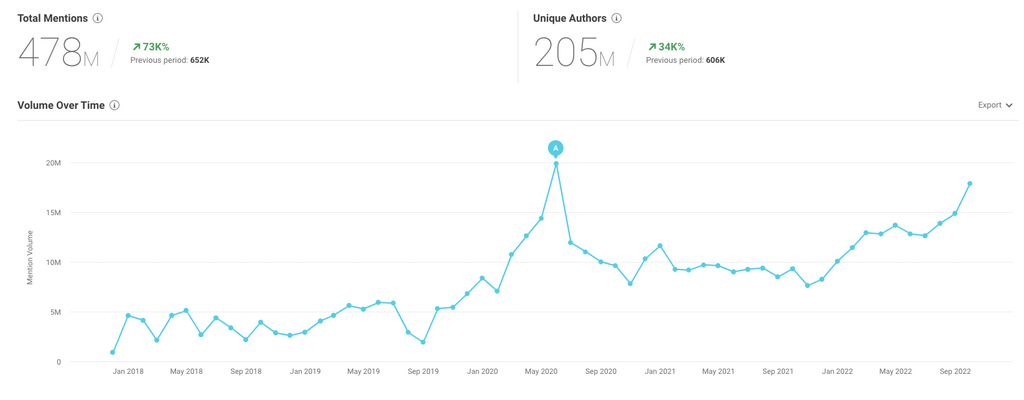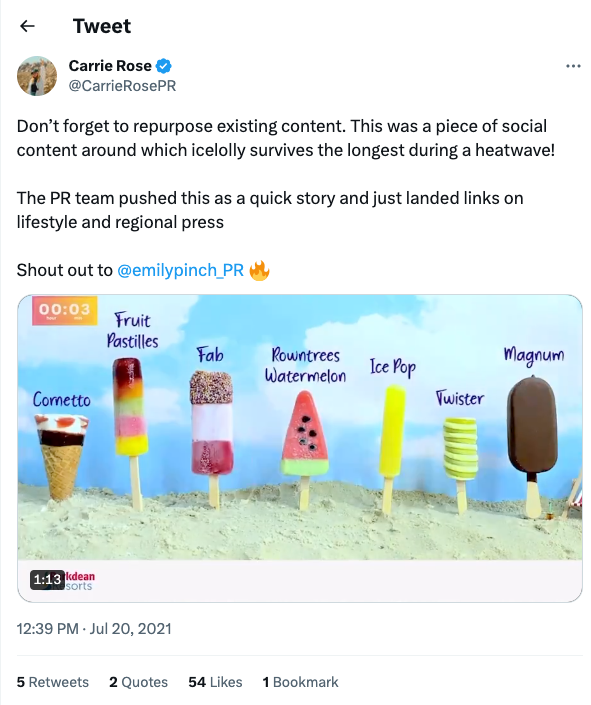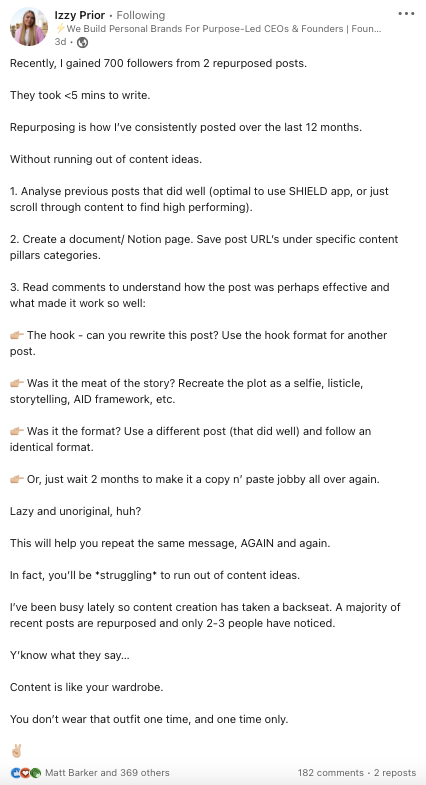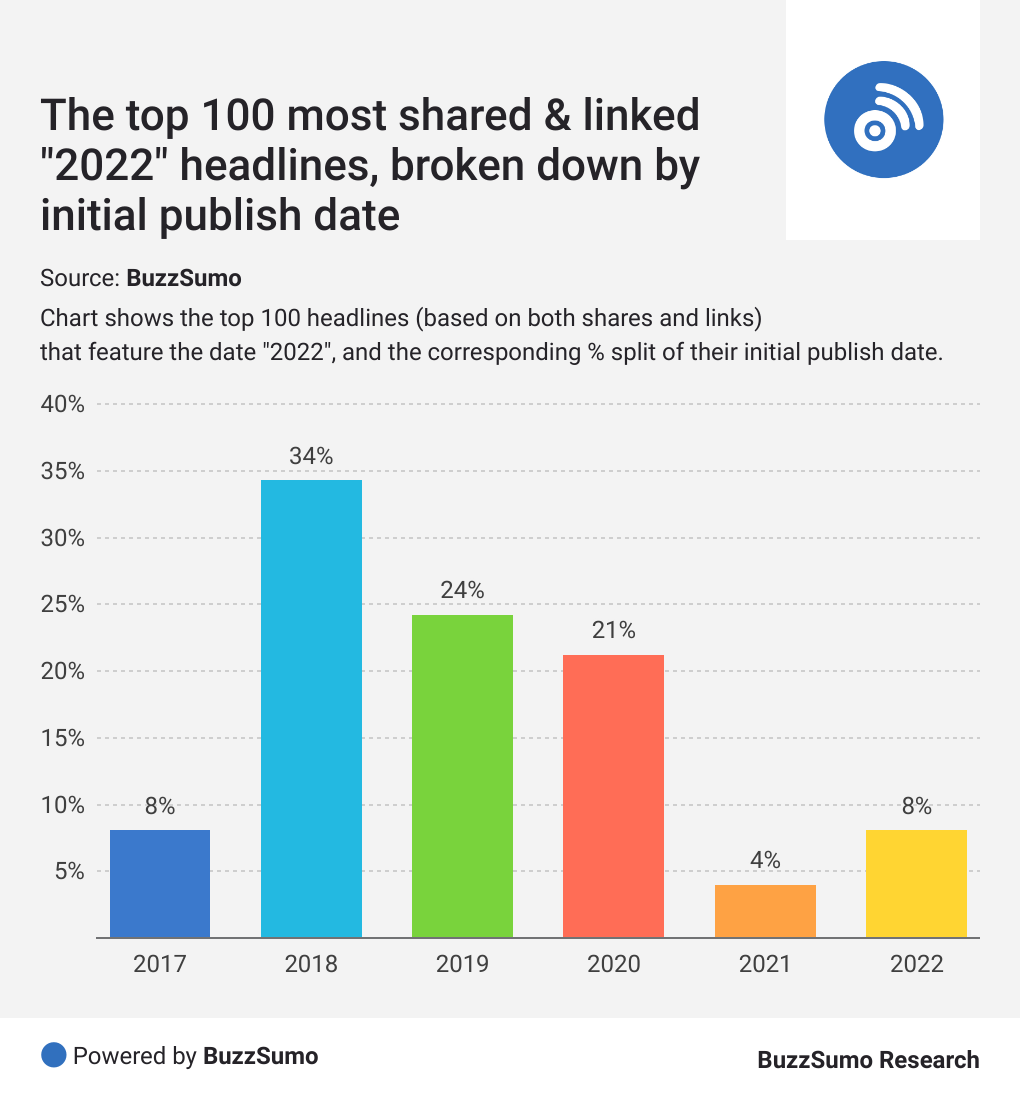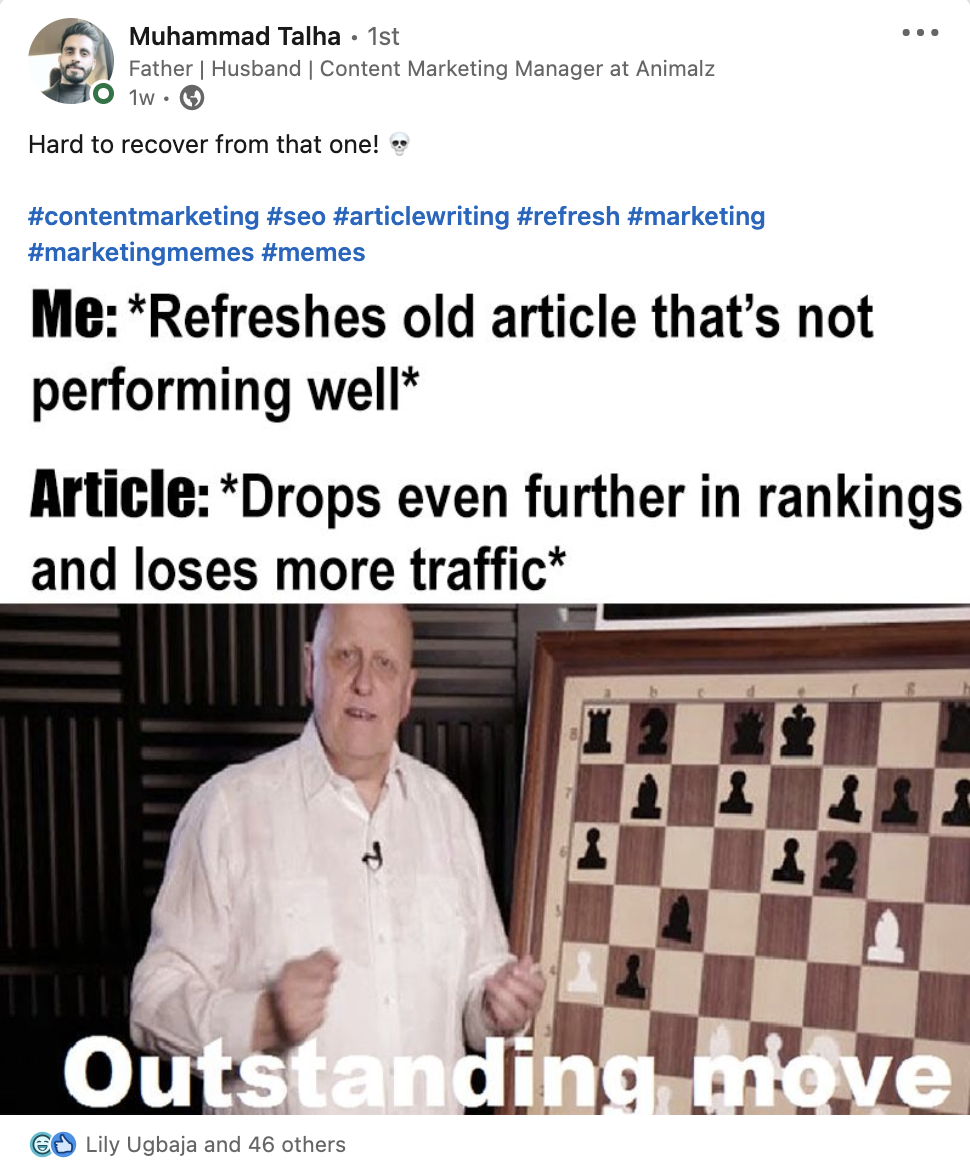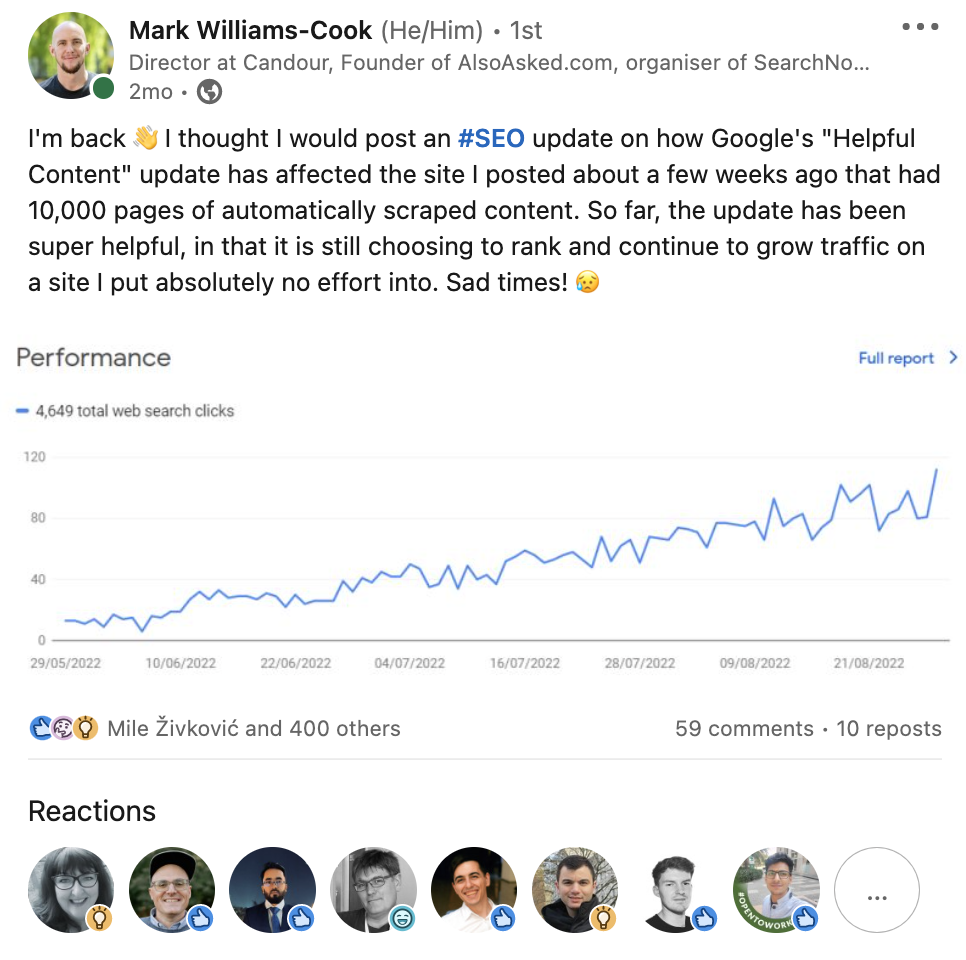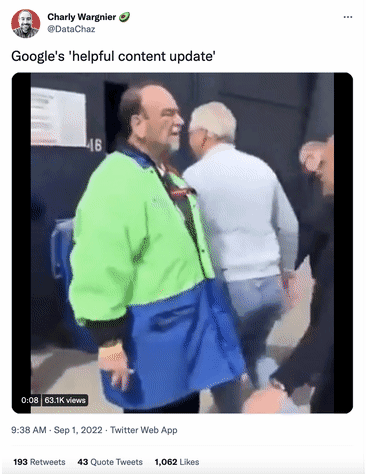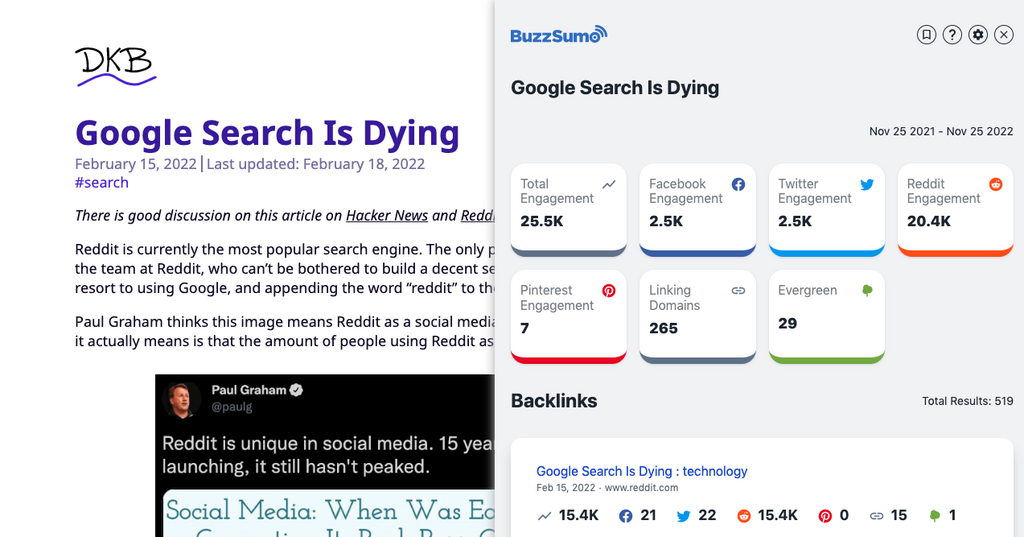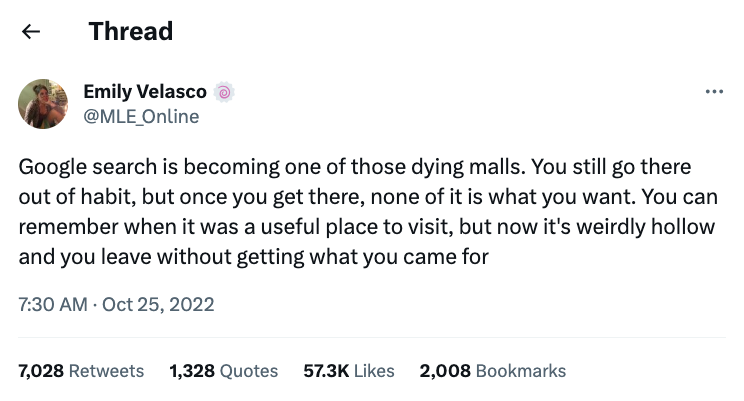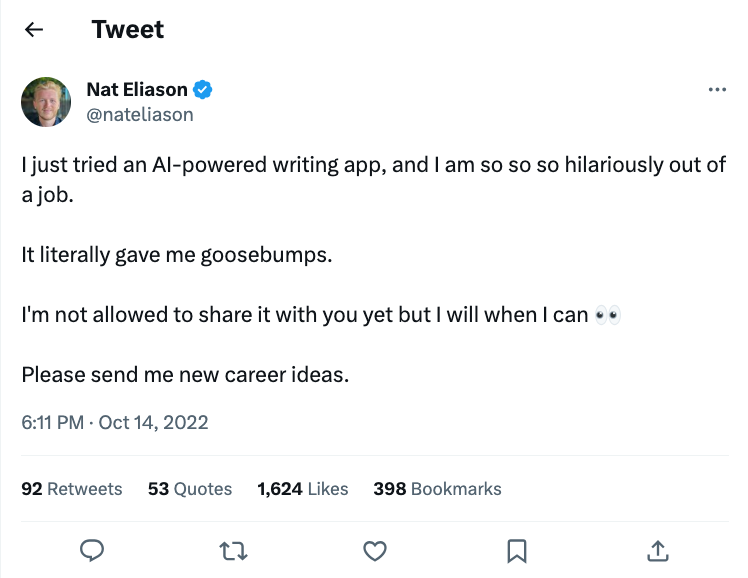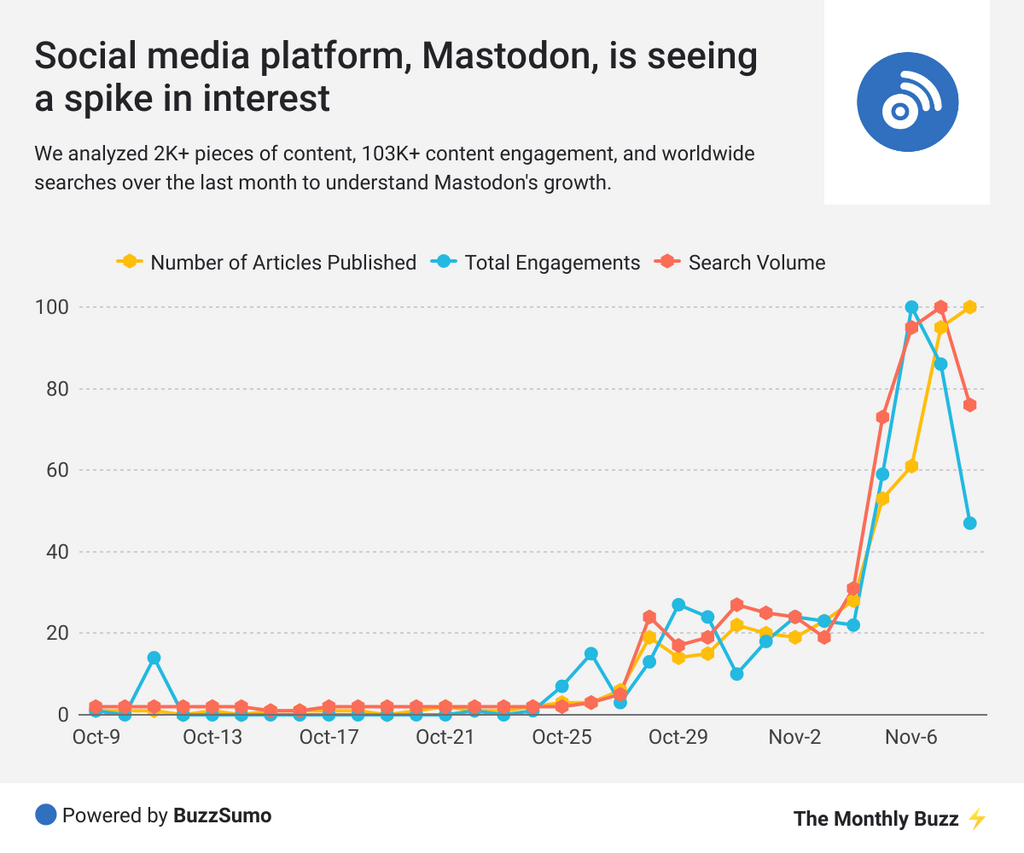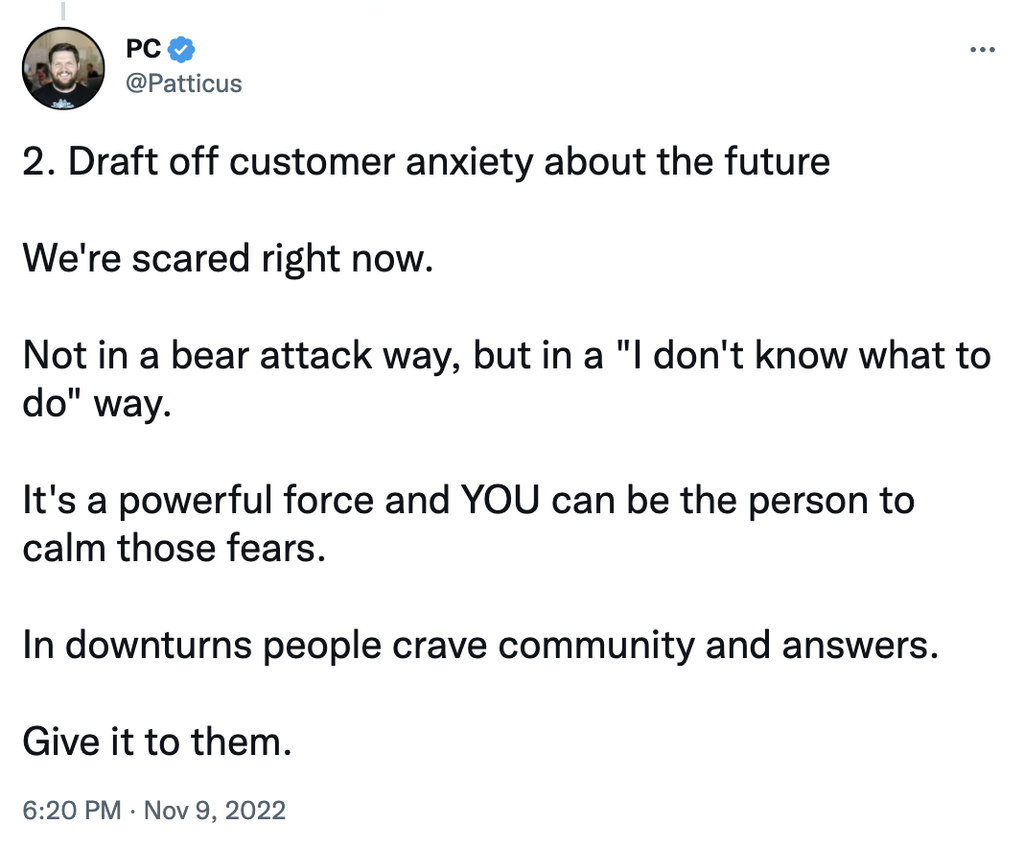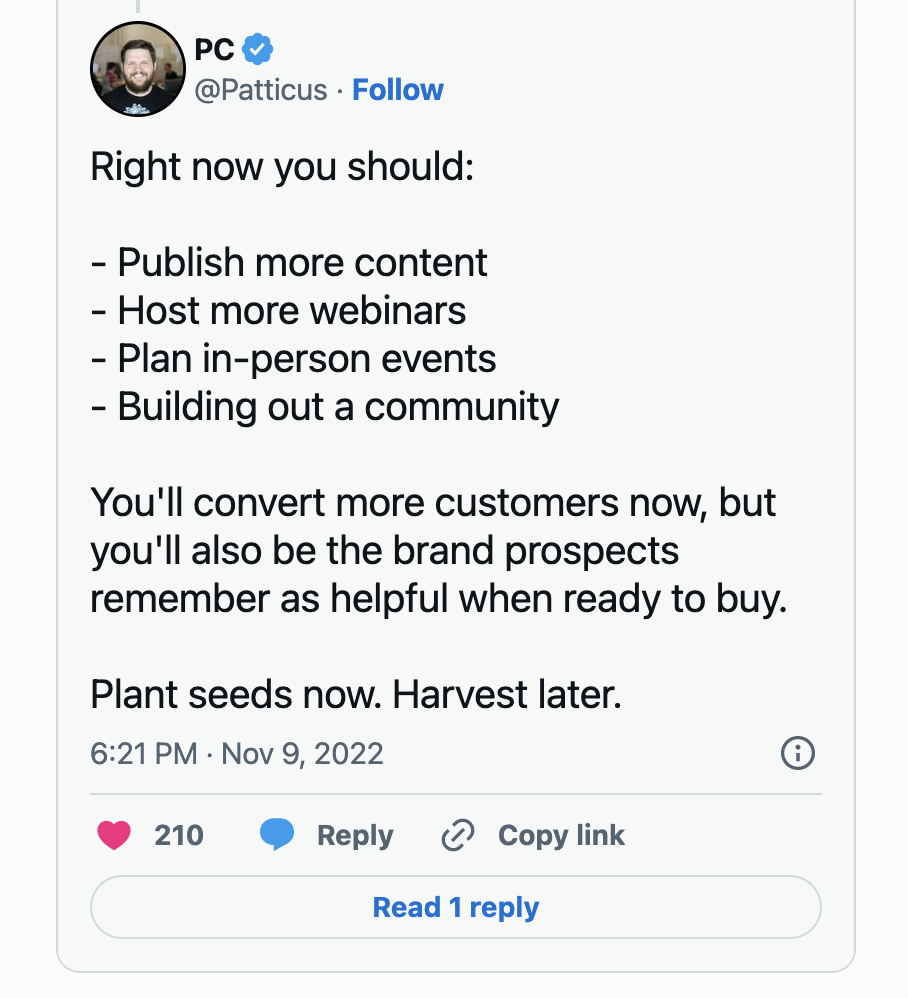8+ Content Trends Agencies Need To Know In 2023
We’ve tapped into BuzzSumo engagement, and picked the brains of some agency experts, to envisage what content will look like in 2023.
And the crystal ball 🔮 says…
1. We'll repurpose content more than ever before
2. We’ll refresh a LOT of content
3. We'll deprioritize rankings and question Google
4. We'll find (and answer) customer queries in new places
5. We’ll bust through boring tasks and writers block with AI & GPT3/4
6. We'll make social our destination
7. We’ll seek out new social platforms
8. We’ll recession-proof our content
Plus:
9. We’ll have to do more to impress journalists with our content
10. We’ll focus less on link volumes
11. We’ll diversify client content strategies and link portfolios
1. We'll repurpose content more than ever before
Once upon a time, the MO of a marketer was to scale content to the nth degree.
This meant churning out blogs on an almost daily basis, and moving straight on to the next Shiny New Thing – to the detriment of actual engagement.
But it’s safe to say we’ve matured as an industry since then, and are waking up to the power of attrition.
And the way things are going, that’s only set to continue into 2023.
A search in BuzzSumo’s Content Analyzer for the phrase “repurpose content” shows a 46% increase in headlines surrounding the topic.
While this isn’t an analysis of the actual act of repurposing, we can infer correlation between the practice and the documentation of it.
We’re all busy people. Add into the mix that our attention spans are now predisposed to micro-content, and that social media platforms are doing everything in their power to keep us in-app, then repurposing content becomes all the more important.
And that’s why short-form, native social content is such an important vehicle for advertising your clients’ owned content.
Formats like Twitter threads, Instagram reels, TikTok videos, and LinkedIn carousels act as a mini elevator pitch to push audiences to the web content that will eventually convert them.
Audience’s TL;DR attitude means that more marketers are prioritizing content repurposing over content creation.
Twitter threads in particular are springing up all over the place. They’re a great way to distil big ideas, and get more mileage out of long-form content.
In fact, we used Brandwatch to analyze the uptick of the word “thread” and the emojis: 🧵and 🪡, and found that Twitter threads have seen a staggering 73 thousand percent increase since their inception in December 2017, peaking highest during the pandemic.
That’s a lot of content repurposing!
Upcycling is a brilliant way to extend the lifecycle of content for clients with limited budget and resources.
And it can extend to press coverage.
In fact, PRs are usually brilliant at repackaging content, since their bread and butter is teasing out new angles for pitching to journalists.
Check out this example of a Twitter poll that was repurposed for press coverage by PR agency Rise at Seven.
The practice of repurposing opens up your clients’ content to new audiences, and reinforces the message of their brand or campaign.
Repurposing is a form of distribution, and should be baked into your clients’ strategies.
Here are a few relatively low-lift ways you can take your clients’ content on tour:
And here Izzy Prior from Spark Social Media shares some awesome advice for repurposing:
For more tips on repurposing content, check out our guide: Repurposing Content Guide: Best Practices, Tips, and Real-World Examples
2. We’ll refresh a LOT of content
In a similar vein, marketers are investing more time into refreshing content, rather than starting from scratch.
This year, we did some research for The Monthly Buzz to get a handle on just how often content was getting updated.
We looked at the true publish dates of the top 100 headlines featuring the year “2022”, to understand how often popular content gets updated.
The majority of today’s most shared and linked content was first published four years ago in 2018.
In fact, only 8% of the “2022” headlines were actually created in 2022.
Updating a single piece of content in this way can afford you the time to be smarter, and make your clients’ content work harder.
Instead of researching, planning, and creating new content every time, invest in optimizing it.
Try repurposing, applying schema, or conducting outreach, to build your clients’ authority over time.
For actionable tactics on how to update content, check out one of our guides:
3. We'll deprioritize rankings and question Google
Improving your content doesn’t necessarily mean improving your rankings – and we’re getting wise to that fact.
This LinkedIn post from Muhammad Talha, Content Manager at Animalz conveys that sentiment in a pretty comical way.
Despite this, we’re not afraid to rock the ranking boat if it means creating something that’s genuinely helpful to our audience.
There are ranking anomalies in Google, with top-tier content struggling to gain traction, and old, ill-informed content sailing along in position one – uninterrupted for many years.
Even after Google’s helpful content update, this still seems to be the case.
As an industry, we’re getting less enamored with Google, and less obsessed with ranking movements and technicalities.
In a ContentUK Members Webinar, Ahrefs’ CMO, Tim Soulo, said he chooses to prioritize quality and audience intent when updating content, even if it hurts rankings.
Gisele Navarro, Co-Founder of NeoMam Studios, published a manifesto on creating great hero content, with the message that "The future of link building is to stop thinking about the links."
And the SparkToro team actively avoids SEO, as the demand for their offering doesn’t exist on search engines yet.
Instead, they embrace what they call “Modern content marketing” by tapping into the conversations and social spheres of their customers.
Google’s helpful content update was a call to action, imploring content marketers to think reader-first – not search engine-first.
But why?
Simply put, quality content is in limited supply right now. Google is full of copycat blogs with a dearth of actual useful advice or expertise.
Software Engineer Dmitri Brereton wrote about this, and many more of Google’s shortcomings, back in February 2022 in a piece titled: Google Search Is Dying.
To date the article has amassed a hefty 25.5K shares and 265 links, according to BuzzSumo’s Chrome Extension.
It also catalyzed lengthy discussions on forums like Reddit and Hackernews.
In fact, engagement surrounding the piece was so pronounced that Google’s Search Liaison, Danny Sullivan, felt compelled to respond.
This article inspired The Atlantic to publish an op-ed piece: Is Google Dying Or Did The Web Just Grow Up?.
And, to date, that has accumulated 6.2K shares and 135 links.
Twitter posts sharing that same sentiment haven’t been uncommon.
The one below has received no less than 59.6K likes.
If Google is on the decline, then it’s not a stretch to imagine that it really needs us to get better at creating content.
It’s a classic feedback loop.
Google needs us to up our content game, so that it can advance its understanding of quality content, so that our quality content can rank better.
The more Google wills creators to produce valuable content, the more valuable its service will (hopefully) be.
(On a slightly more sinister level, Google might also need this training input to improve and prioritize its own content natively in the SERPs. That means ranking above third-party sites like yours and mine, but I digress 😅)
For agencies, this trend means continuing to steer clients away from obsessing over rankings.
And it means moving them towards centering customers, understanding intent, and creating genuinely useful and unique content.
Instead of just summarizing the top ranking blog posts, guide them to write more like journalists, who find a story, research the heck out of it, and center expertise.
Explain that rankings will be hard won in the short term, but over time their efforts will come to fruition.
And in the meantime, measure and reinforce the improvement in their brand perception.
Focusing less on rankings also means steering them towards other channels that will work for them.
This year Onclusive studied the reach of 100K articles, and reported:
"Of all the media characteristics we analyzed, the level of social media engagement emerged as the biggest predictor of website traffic, with highly engaged articles driving 113% more website visitors than low-engaged articles. The correlation is even more pronounced when it comes to website actions, with highly engaged articles driving 280% more website activity than low engaged articles."
Prioritizing social media in your client’s strategies in 2023 is a shrewd tactic for offsetting ranking volatility, and driving quality traffic and leads to their site.
4. We'll find (and answer) customer queries in new places
One of the major critiques made by Dmitri Brereton in his lambasting of Google, was that it’s hard to trust the authenticity of the content we’re served.
In fact, in his very first sentence he writes...
"Reddit is currently the most popular search engine... The SEO marketers gaming their way to the top of every Google search result might as well be robots. Everything is commercialized. Someone’s always trying to sell you something. Whether they’re a bot or human, they are decidedly fake. So how can we regain authenticity? What if you want to know what a genuine real life human being thinks about the latest Lenovo laptop? You append “reddit" to your query (or hacker news, or stack overflow, or some other community you trust)."
While this is a bit of an extreme take on things, it clearly demonstrates the user trend towards using social media for research.
Audiences, especially Gen Zs, are searching on Instagram, Reddit, and TikTok rather than Google, to seek out unique and trustworthy content.
Here’s how Digital Marketing Agency, Hallam, thinks agencies should be responding to this trend in 2023.


5. We’ll bust through boring tasks and writers block with AI & GPT-3/4
Recent developments in AI content tools have left marketers and writers feeling a little iffy…
The rise of AI has led to a peak in online interest.
In fact, content engagement surrounding AI generated content has grown by 91% over the last five years, and 33% of all that engagement happened this year…
AI content tools like OpenAI.com's ChatGPT and word processors like Lex and Notion have blown up in 2022.
In fact, in just two weeks, the ChatGPT page earned 15.9K shares, and 732 links, as everyone hopped on this mind-bogglingly convincing content tool.
And with this uptick in interest came feelings of equal parts excitement, distrust, and unease.
How can we harness AI to make our lives easier? Will our jobs be replaced by AI? Are we heading towards the singularity?
Let’s take a look at relative merits and drawbacks of AI generated content
Disadvantages right now:
- AI content tools can’t predict the future. Right now they rely entirely on input from you, and what's already out there on the interwebs. They can’t generate content from scratch. Alas, I wouldn’t be able to use an AI tool to create this 2023 trend guide 😢 And believe me I tried! The content was repetitive, example-free, and the trends were so passé (2017 called and they want their voice search back).
- They currently don’t create convincing long form content (according to Danny Richman who gave a great talk on AI generated content and using GPT-3 for keyword research at BrightonSEO).
- AI content can make inaccurate statements and claims or plagiarize.
- In my opinion, some of the copy generated from AI tools has been a little fluffy and surplus to requirement – and that’s not just me trying to defend my job – honest! 😅. Arguably, this could lead to an uptick in lower quality content. And, if we start creating a sea of average content via AI, this will actually stimy AI from developing, since it uses web content to train and learn.
- Google doesn’t trust AI generated content, and has ruled that it is against guidelines.
Advantages of AI generated content right now:
- It’s great for curing writer's block.
- It can help you in the ideation phase.
- It helps to speed up the writing process.
- It’s cost effective to pay a monthly subscription for thousands of words, when compared with a salary.
- You can use it to scale tedious tasks – eg.
- Meta titles & descriptions
- Product synopsis / generic text
- Headline creation
- Content outlines
Though there are early fears of job security, automated content isn’t a replacement for:
- Original ideas
- Creativity
- Strategies
- Opinions
- Predictions
- Personality
But what it is good for is short form content ideas, and helping-hand copy that either gets the cogs in your brain whirring again, or enables you to scale tedious copywriting tasks.
While some agencies may use and abuse AI to create reams of low quality content, others will use it to hone theirs and their clients’ craft.
In fact, there’s arguably a place for “AI writer” jobs, to monitor and improve the outputs of AI content.
Agencies need to stay at the forefront of burgeoning content trends like AI, to not only be seen as knowledgeable and authoritative, but to stay competitive.
AI generated content will allow them to create scalable, ROI-driven strategies both in-house and for their clients.


6. We'll make social our destination
Social media platforms have shaped their algorithms to deprioritize external content for a while now.
It makes sense. When users wander away from a platform they consume less ads, and generate the platform less revenue.
That’s why we all started commenting on our own LinkedIn posts – to disguise our links as engagement, and continue driving traffic back to our sites.
And it worked!
On LinkedIn at least… A study by Growth Rocks proved that this tactic resulted in better reach and more clicks.
But one of the other key reasons algorithms prioritize sans-link content is because users don’t always want to leave.
As Amanda Natividad, VP of Marketing at SparkToro, says in How to Get Started with Zero-Click Content with Amanda Natividad:
“Zero-Click Content provides valuable, stand-alone insights with no need to click. Clicking would be additive to the experience, but it’s not required. This is why Twitter threads, LinkedIn posts and carousels are so popular. Because people are staying on these platforms to scroll through this content. Nobody goes to Twitter with the hopes of immediately leaving Twitter.”
Remember – social posts are a TL;DR sales pitch for content.
In 2023, you need to be drip-feeding these pitches into your clients’ social strategies, to help them win the algorithm.
When they’ve racked up more engagement, that’s the time to introduce their external content.
7. We’ll seek out new social platforms
According to The Drum, Mastodon has hit the 1m monthly user mark, gaining 489K new users since October 2022, while Hive Social more than 750K new users in a week, in November 2022.
Content engagement and search volume trends reinforce this growth. In fact, engagement around Mastodon grew by 131% between 2017 - 2022.
So, should we all just move to Hive Social or Mastodon?
Well, no. According to The Drum, Mastodon poses brand safety concerns, and doesn’t allow paid advertising in the first instance.
Similarly, Hive Social is made up of just three people, and has no content moderation team, making it susceptible to hate speech and violence.
TikTok, on the other hand, saw the biggest bump in ad activity ever in October 2022, with 60% YoY uplift in traffic to its ad pages, as reported by the Morning Star.
According to the same source, LinkedIn (23%+) and Reddit (50%+) also experienced a boost.
At this point it's fair to say that agencies should consider guiding clients towards honing social strategies on varied platforms.
8. We’ll recession-proof our content
In 2023 the recession will be in full swing, if you’ll believe Bloomberg’s latest reports.
So what should you and your clients do to weather the storm?
Focus on retention content
Creating helpful customer content is just about the most important thing you can do in a recession.
Why? Because zeroing in on customer satisfaction is one of the most cost effective ways to market.
According to Harvard Business Review:
“Acquiring a new customer is anywhere from five to 25 times more expensive than retaining an existing one [and] increasing customer retention rates by 5% increases profits by 25% to 95%.”
Target recession-proof industries
Healthcare and education are examples of industries that are less impacted by economic downturn.
Consider this in yours and your clients’ content strategies. Could you build out content moats to target these industries? Invest in ad targeting? Or create account based content?
Invest in tools to improve content efficiency
It sounds counterintuitive, but investing in the right content tools now can save you time, and help you scale.
You could invest in the AI content tools mentioned earlier to save you time on repetitive content tasks, or in tools like BuzzSumo (💁♀️) that help you build campaigns, outreach to the right journalists, and analyze engagement strategies.
Manage expectations
Unless yourself or your client are fortunate enough to be in an unimpacted industry, you should expect lower demand, and communicate that widely.
It’s also the time to start under-promising and over-delivering!
Build communities
At a time of uncertainty, offer stability.
Allay client fears, have frank discussions, and build support networks.
People will remember you for it.
Monitor content performance closely
Take a temperature check of competitor content to make sure that yours or clients' negative performance is definitely symptomatic of the recession.
In a recession, you may see stable content rankings and ad impressions, even when engagement and searches are trending down.
Kevin Indig discusses this in his podcast: The Contrarian Marketer
“If input is stable, but output all of a sudden grows / declines, there’s probably a macro trend at play here.”
Track demand and be prepared to pivot
The 2023 recession won’t look like the one back in 2008. No two recessions are the same.
That’s why it’s crucial to track demand and interest.
Are certain topics tanking or skyrocketing?
Monitor social engagement, track search trends, and be prepared to shift strategies.
Market more
Now is not the time to pull in the reins. If demand is dipping, you need to create it.
Take advice from Patrick Campbell, CEO of ProfitWell, and up your content outputs.
Invest in thrifty content
This takes us back to points #1 and #2 – repurposing and upcycling content can save a lot of time and money, and are all the more important to implement in a recession.
More trends from the agency experts...




Wrapping up
Whether it’s community-building, recession-proofing, or refreshing, optimizing, and updating content, the theme underpinning 2023 is long-termism.
As an industry, we’re learning to be more patient.
We’re not demanding instant content gratification, and instead investing in our content, and making it work harder for us.
But bear in mind, this may not always be the approach of clients that need to meet big goals, yesterday.
In 2023, agencies will need to work even harder to educate and sell-in the value of a long-term, quality-focused content strategy.
